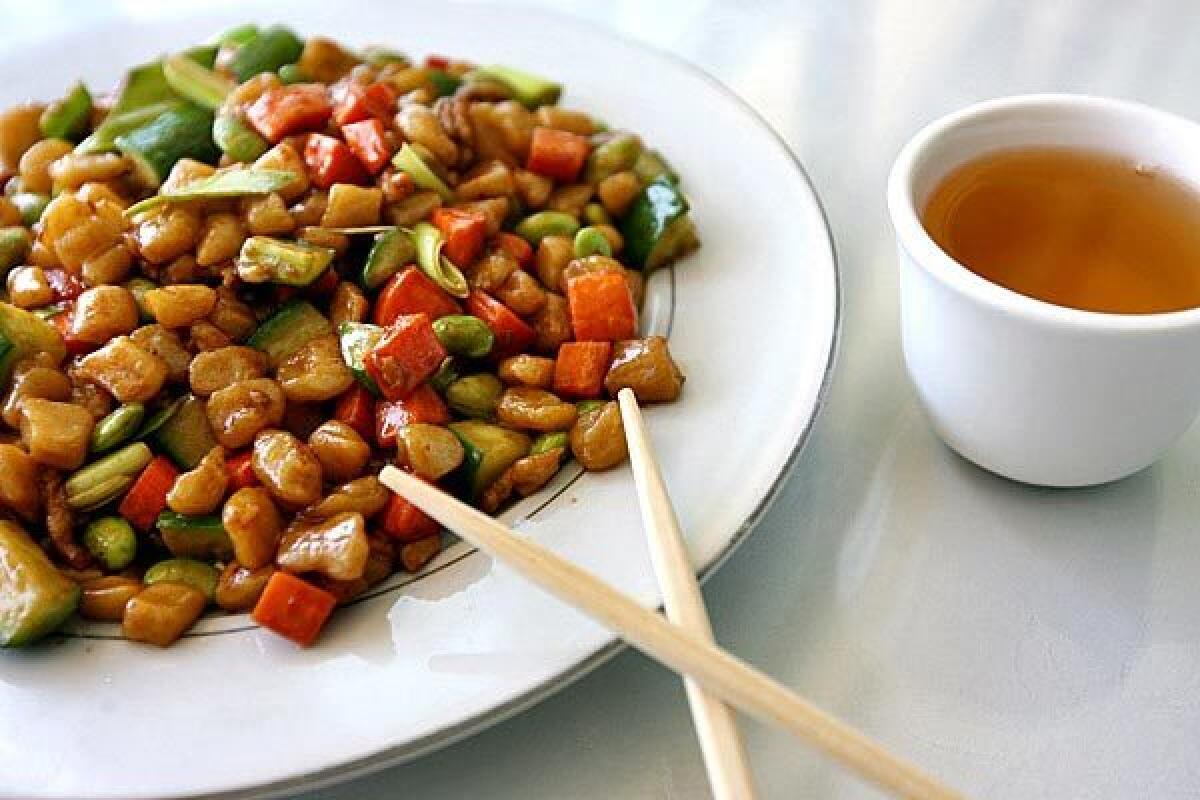The Find: Beijing Restaurant in San Gabriel

- Share via
If you’re on a quest for the holy grail of noodles, then go to the newly opened Beijing Restaurant, a homey restaurant on the second floor of one of the classier strip malls in San Gabriel.
FOR THE RECORD:
The Find: A June 24 review of Beijing Restaurant stated that ge da noodles could be found only at that restaurant and at Tianjin Bistro. Ge da is available at other restaurants in the Los Angeles area. —
In fact, everything here that involves any manipulating of dough is excellent. Turn to the largest section of the menu, labeled “pastry.” It’s an academic investigation into meat-plus-dough possibilities, an extended set of variations of the theme of dumpling and noodle.
All of the dough is made fresh and by hand, shaped into dozens of subtle variations. Every dumpling wrapper and bun is tweaked to match the particular heft and texture of its filling. The “meat pie” is a fat, squat puck of a dumpling, about the size of a slider, with a dense, dry beef filling, surrounded by a firm, thin wrapper. The fried pork and chive dumpling has a softer, looser, juicier filling, wrapped in a softer, pillowier, thicker wrapper, with an outer edge of pan-fried crispiness.
But the radiant center of chewing glory here is the ge da noodle, an old-style Beijing home-cooking specialty that’s hard to find, even in Beijing. Ge da is made from a dense rolled tube of dough, cut into slightly different shapes for each dish. Beijing Restaurant’s version is a serious contender for king of the thick, chewy Chinese noodle scene in Los Angeles.
For the dish called “fried ge da,” the ge da is cut into fat little cubes and stir-fried for maximum chewiness. It’s a little dumpling of dense dough, like a bouncier, chunkier, firmer big Chinese cousin of spaetzle. The dish comes as a pile of little nibble-ables with cubed carrots, slices of squash, whole soybeans.
For a more suave and soothing experience, go for the ge da soup, with bigger hunks of ge da simmered until just a touch soft. The soup is almost a visual tease — big, white, soft, cloud-like clumps of ge da and big, soft clouds of white egg, almost identical, all floating in a warm red tomato broth. The ge da in the soup is softer, slipperier and sweeter than the stir-fried ge da, but it still has spunk. If the fried ge da is like verbal sparring with Katharine Hepburn, the ge da soup is like holding hands with Audrey Hepburn.
Beijing is a crossroads city, and Beijing cuisine is a melting-pot metropolitan style, with influences from all over China. The predominant style is Shandong, the cuisine of the coastal Chinese provinces. Shandong cuisine is a clear cousin of Cantonese cuisine: Many of the techniques and spices are different, but the emphasis is on preserving and emphasizing the original flavors of the ingredients.
Chef-owner Jing Wang has been cooking Shandong and Beijing cuisine for 30 years. To make ge da well is purely a matter of experience, Wang says; there is no recipe that will work day in and day out. Everything — the temperature, the ambient humidity — will influence the texture of the noodle. Success, Wang says, comes from the cook’s expertise, and how he observes and adjusts the dough as it develops.
The rest of the “pastry” section of the menu is full of other simple delights. Fried dumplings come with several fillings; the loveliest is the lamb dumpling — a long, flat, carefully folded package, crispy and pillowy on the outside — which will dribble hot, savory lamb juice all over your face.
The amusingly undescriptive name “pork with cooked pie” is a steamed white bun, smushed flat and crisped on the outside, then sliced halfway open, and stuffed to the brim with soft, sweet cubes of pork and a few beautifully gelatinous cubes of pork fat, and spiked with cilantro. The bun is surprisingly, happily dense; the pork is soft and falls apart a moment after it hits your mouth. It’s like the Beijing version of a sloppy Joe.
Authentic Beijing-style cooking is strangely rare in Los Angeles. Other styles of Chinese cooking, such as Sichuanese and Shanghainese, are omnipresent, but Beijing specialties are almost impossible to findable. The only other place one might find ge da, for example, is Tianjin Bistro, which Wang used to own.
Though two-thirds of the dishes come out precisely the same shade of shiny brown, the uniform coloring hides subtle, careful cooking. Try sautéed “triple delight,” a careful preparation of a variety of organ meats. The glossy-brown sauce hides exactingly stir-fried slices of liver and kidney and fresh, sweet, just barely crisp vegetables.
Afterward, if you need help jump-starting your carb digestion, try a foot massage. There are three different foot massage parlors in the same strip mall, all offering the same deal: a one-hour foot massage for $15.
More to Read
Eat your way across L.A.
Get our weekly Tasting Notes newsletter for reviews, news and more.
You may occasionally receive promotional content from the Los Angeles Times.










